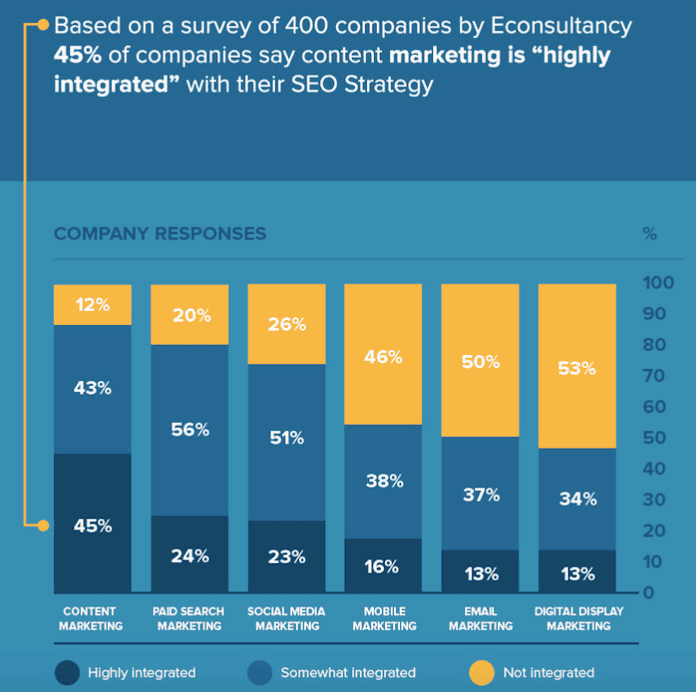A picture is worth 1000 words.
It’s true in general, but it’s particularly true in marketing. And for good reason: visual content is far more appealing than plain text.
If you’re not quite convinced, have a quick look at the data. Posts on Facebook and Twitter receive over 1.5 times more engagement when they contain images (HubSpot). The rise in popularity of image-based social networks, like Instagram and Snapchat, is even further evidence that visuals are here to stay and must be incorporated into your marketing strategy.
If you’re completely new to visual content and don’t know where to start, there is no need to worry. We’ll explore the basic do’s and don’ts of leveraging visuals in content strategy, and teach you how to explore this new facet of your marketing plan.
Here are 8 visual content tips (do’s and don’ts) to help you get the best results.
Do Develop a Strategy Before Beginning

Due to its nature, visual content requires a whole new set of resources compared to its text-based counterpart. If your business isn’t already equipped with design support, tackling visual content will be a significant task.
Having a clearly defined strategy in place before you begin visual content production helps make the content creation process less daunting and minimizes the waste of company resources.
For a list of resources for creating visual content, read 40+ Tools to Create AWESOME Visual Content (and Boost Engagement Too).
Your strategy should reveal to you exactly what needs to be accomplished with this new aspect of your overall marketing campaign and ensure that the visual content you create is as effective as possible.
A simple way to begin your visual marketing strategy is by repurposing pieces of text-based content into visual content. For instance, if you sell accounting software, and you’ve previously written a blog post aggregating statistics about corporate taxation policies, you could easily use the data from that post to develop an infographic.
Do Publish Data in Visual Form
Data-related topics have always been and will always be a mainstay in content marketing. Especially in B2B industries, target audiences love to learn the cold, hard facts and statistics of how a product, service, or strategy can help their company reach its goals.
In text-based content, white papers, case studies, and even blog posts are the typical ways companies deliver data to their audience. Visual content, however, is a far better channel for data, as you can communicate a lot more data in less time to your readers with graphs, pie charts, tables, etc.
Remember that visual and text-based content appeal to different audiences who enjoy consuming content in two different ways. Visuals appeal to those who want an easily digestible snapshot of data, but they can also act as a segway to entice viewers to take a deeper dive by reading more in-depth text content.
Here’s an example of how Neil Patel over at QuickSprout uses infographics in his visual content strategy to deliver data to his audience.

Do Tell Stories
Even in visual content, storytelling is still one of the best ways to connect and engage your audience. When you’re able to weave a story into the content you create, readers are drawn into the narrative and feel emotionally invested in the outcome. Thus, they develop a real relationship with your brand.
Videos are an excellent way to expand your storytelling efforts to your visual content strategy. For inspiration, just take a quick look at any Kickstarter project. A significant majority of the successfully crowdfunded campaigns contain promotional videos wherein the founders begin by telling the story of how the company came to be.
The formal clothing company, Ministry of Supply, used a video on its Kickstarter to spark rapid growth. In the video, the founders discussed the problem with traditional clothing and told the story of how they came up with the idea to reinvent the dress shirt for a performance orientation. The video obviously worked, as the company walked away with over 14 times its initial goal of $30,000.
Do Distribute Video Content Through Multiple Channels
YouTube’s status as the king of video distribution is absolutely undisputed. More than a billion people regularly visit the website, and over 300 hours of video are uploaded to the website every single minute.
Clearly, YouTube is far more popular than any of its competitors, both in terms of viewership as well as in popularity with video creators. However, that still doesn’t mean you should limit yourself to that one platform.
There are benefits unique to the other video platforms like DailyMotion, Vimeo, Twitch, and the like. Each channel has its own unique audience and general video type: Vimeo, for instance, gets over 100 million visitors per month and focuses generally on higher quality video. Twitch contains all things streaming, especially gaming-related content. If your business fits in this kind of niche, you could be better off using one of the smaller video hosts than relying solely on YouTube.
The key is to test out multiple channels by publishing your video content on a variety of hosts and tracking results from each one before deciding on which channel(s) to pursue more seriously.
Don’t Limit Yourself to One Format
As with text-based content, visual content comes in many different shapes and sizes. When you’re writing text, you can create blog posts, white papers, how-to guides, case studies and more.
When you’re creating visuals, you can develop commercial videos, infographics, stock-like images and more. A solid visual marketing strategy combines and tests out multiple elements.
Be sure to test out different formats—especially the ones you’ve never tried before. You might be surprised how one specific visual content format resonates with your audience!
Don’t Feel the Need to Write Accompanying Text
While text and visuals together can create really engaging content, visual content doesn’t always need a “helping hand” in the form of a text-based summary or introduction. Many types of visual content, especially ones that have their own internal structure (beginning, body, and end) such as infographics and videos, don’t need a supporting leg of text to stand on.
Thus, you don’t have to feel a need to draft accompanying text everytime you publish visual content. Indeed, it could sometimes even turn off visitors if they have to scroll through a wall of text before getting to the visual content that was promised in the headline or the link.
A study done by the Nielson Norman Group discovered that an 86% average difference between how users treat content above and below the fold (the section of content visible to the user without needing to scroll). The study’s authors found that visual elements entice the reader to keep scrolling more than text does, so having a wall of accompanying text above the visual content could stop visitors from ever scrolling down to actually view it.
Don’t Settle for Ordinary Design
As we discussed above, visual content can be a significant expense. Well-designed visual content is gonna set back your marketing budget even more.
However, that extra expense is absolutely worth it.
Because of the nature of visual content, few people are willing to engage with a poorly-designed infographic or video. Not only is such visual content aesthetically unappealing and thus a mental turn-off, but crude design can also obscure the information you’re trying to present.
Also, remember that visual content has increasingly become an integral component of digital marketing strategy. Louise Myers reports> that 74% of social media marketers already use visual content in their strategy, so the only way your campaign will stand out to your audience is with strong design and unique visuals that rise above that of your competitors’.
When starting out in your visual content strategy, set the bar high right from the get-go with well-designed content that conveys the required information clearly, created by talented professionals. If your budget doesn’t yet allow for this, I would recommend waiting until it does. Poor design that looks unprofessional can do more harm than good, damaging your brand reputation.
Don’t Expect Your Visual Content to Market Itself

Just as with text, crafting amazing visual content is only the first step in the marketing strategy. The second (and arguably more important) step is, of course, promoting it. After all, why go to all that time and expense creating a well-designed infographic if it never reaches more than a couple of viewers?
Don’t expect your content to market itself just because it’s visually appealing. True, it’s generally easier for a video to gain traction than a blog post simply because visual content is more engaging to viewers. However, that doesn’t mean your video will automatically attract traffic as soon as its published. It still needs a helping hand from your marketing team to get the ball rolling.
After publishing a piece of visual content, make sure to promote it heavily on your own social media channels. Then, network with other influencers in your industry to get the content in front of their audiences as well. Finally, continue linking to the content in the future, this allows you to create strong internal linking throughout all your content.
Wrapping Up
In many ways, visual content can be significantly more challenging than text. Not only can it require more time to coordinate and more money to develop, but you may find yourself having to bring in external teams to actually create content, adding outsourcing to the already-significant burden of every marketing team.
The benefits, however, are well worth it. Well-executed visual content will help elevate you up above your competitors and it has the potential to create unparalleled engagement with your audience. Use the tips above, and you’ll be well on your way towards developing a solid visual content strategy.

Author Bio: Ryan Gould is the Vice President of Strategy and Marketing Services at Elevation Marketing, a B2B marketing agency. Ryan helps medium and large brands improve sales and market share by developing integrated marketing experiences distinguished by research, storytelling, engagement and conversion.
Connect with Ryan: LinkedIn | Twitter: @ryanscottgould
Connect with Elevation: Twitter: @elevationb2b | Facebook: @elevationb2b


